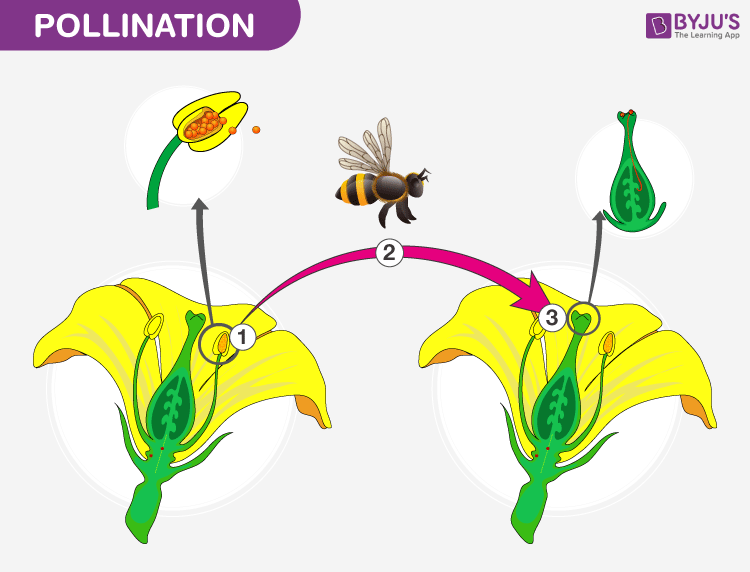Have you ever wondered why bees are attracted to flowers? Flowers look beautiful and are fragrant, but there is a reason behind this – flowers actually help plants to reproduce. Flowering plants have seeds, carry the genetic information of the parents and develop into a new plant.
Explore pollination notes provided here to learn about the process and types of pollination.
Table of Contents
- Pollination
- Process
- Types
- Self Pollination
- Advantages and Disadvantages Of Self Pollination
- Cross-Pollination
- Types Of Cross Pollination
- Anemophily
- Zoophily
- Anthropophily
- Advantages and Disadvantages Of Cross-pollination

What is Pollination?
Pollination is a method where pollen grains are picked from an anther, which is the male part of a flower and transferred to the flower’s female part called the stigma. To make the pollination work successfully, the pollen grains must be transferred from the same species of flower.
Also Read: Sexual Reproduction In Plants
Process of Pollination
The process of pollination begins when the pollen grains from the respective flowers lands on the stigma and form a pollen tube with the style length, which connects both the stigma and ovary. After the completion of the pollen tube, the pollen grain starts transmitting sperm cells from the grain to the ovary.
Later the process of fertilization in plants will take place when the sperm cells will reach the ovary and egg cells. The seed is then released from the parent plant and making it able to grow into a plant and continue the reproductive cycle with the use of the pollination method.
Also Read: Sexual Reproduction in Flowering Plants

Types of Pollination
All plants having flowers completely rely on pollination method for reproduction. There are 2 types of pollination –
-
-
- Self Pollination
- Cross-Pollination
-
Self Pollination
It is referred to as the primary type of pollination as it includes a single flower. Self-pollination occurs when pollen grains fall directly from anther into the stigma of the flower. This process is quite simple and fast, which leads to a reduction in genetic diversity as the sperm and egg cells of the flower share some genetic information.

Advantages and Disadvantages of Self-pollination
-
-
- Self- pollination ensures that recessive characters are eliminated.
- The wastage of the pollen grain is very less compared to cross-pollination
- In the process of self- pollination, the purity of the race is maintained, as there is no diversity in the genes
- In self- pollination, there is no involvement of external factors like wind, water, and other pollinating agents.
- Self-pollination ensures that even a smaller quantity of produced pollen grains from plants have a good success rate in pollination.
-
Disadvantages
The major disadvantage of Self- pollination is there is no mixing up of genes. Due to which:
-
-
- The vigour and vitality of the race are reduced
- The immunity to diseases is reduced in the resultant offsprings.
-
Cross-Pollination

It refers to a complex type of pollination that allows the transfer of pollen grains from the anther of the flower into the stigma of another flower. This method leads to an increase in genetic diversity as different flowers will share and combine their genetic information to create unique offspring.
Also Refer: Difference Between Self Pollination and Cross-Pollination
Types of Cross-Pollination
The process of cross-pollination requires the help of biotic and abiotic agents like animals, birds, wind, insects, water and other agents as pollinators.
Pollination by Wind- Anemophily
There are only a few flowers that use wind pollination and their features are greenish, small and odourless flowers. As these flowers do not attract the pollinators, their energy is not used for making colourful petals. This type of pollination usually occurs when plants lack flowers with nectar and other features including inconspicuous. The male parts of the Anemophilous flowers tend to produce very large quantities of pollen and the stigma, the female reproductive part of a flower are very large, sticky and feathery to extend completely outside the flower. Thus the pollen is more likely to reach them.
Coconut, palm, maize, grasses and all gymnosperms are the best examples of wind-pollinated plants.
You must have seen that your car is fully covered with yellow film in the spring, it is actually the pollen that uses wind for pollination process.
Also Refer: Gymnosperms
Pollination by Animals – Zoophily
Animals play an important role in plant reproduction. They help in seed dispersal. When an animal eats the fruit of a plant, they move to a different location. This movement helps in spreading the seeds and with this, we get new plants to new locations.
Artificial Pollination – Anthropophily
Artificial pollination is done by human beings. This process is also called as the Anthropophily. If there are any difficulties in the pollination process through abiotic or biotic agents, the artificial method of pollination is performed by spreading pollen grains over the female flowers. Hybridization techniques are also used in this process.
Advantages and Disadvantages Of Cross-pollination
Advantages
-
-
- The produced seeds are good in vigour and vitality.
- All unisexual plants can reproduce through the process of Cross-pollination.
- The recessive characters in the lineage are eliminated as a result of genetic recombination.
- This process improves the immunity of the offsprings towards the diseases and other environmental factors.
- Cross-pollination introduces new genes into a sequence of species and this is mainly due to the fertilization between genetically different gametes.
-
Disadvantages
-
-
- In this process, there is a great wastage of pollen grains.
- Due to genetic recombination during meiosis, there are chances of eliminations of good qualities and additions of unwanted characteristics in offspring.
-
Also Read: Artificial Hybridization in Plants
Learn more about pollination, its types, and other related topics at BYJU’S Biology
Recommended Video:


I really liked this site
Yes, dude, really good at the level of ncert
This Site Is the Coolest Site For NCERT In Their App That is BYJU’s Also they explain very well